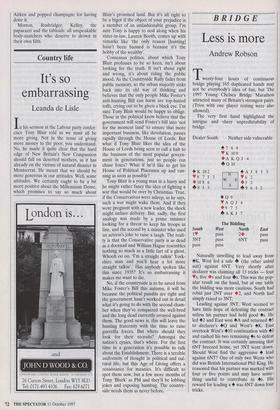BRIDGE
Less is more
Andrew Robson
Twenty-four hours of continuous bridge playing 165 duplicated hands may not be everybody's idea of fun, but The 1997 Young Chelsea Bridge Marathon attracted many of Britain's strongest pairs. (Trios with one player resting were also allowed).
The very first hand highlighted the intrigue and sheer unpredictability of bridge.
Dealer South Neither side vulnerable 47 6 4
• K 109 • A K J 4 C) 10
4K 102 4A J
8 5 3 W E • 8 7 • 10 8 5 6 3
• 6 • 3 2 2
+8 5 3
9 6 4 2
4 Q 9
• A CH 4
• 9 7 5
+ A K J 7
The Bidding South West North East
1V pass 2* pass 3NT pass 6NT pass pass pass Naturally unwilling to lead away from 4K, West led a safe • (the other unbid suit) against 6NT. Very shortly after declarer was claiming all 13 tricks — four Vs, five *s and four *s. This was the pop- ular result on the hand, but at one table the bidding was more cautious. South had rebid just 2NT over 42, and North had simply raised to 3NT.
Leading against 3NT, West seemed to have little hope of defeating the contract unless his partner had held good 4s. He led 42 and East won 4A and returned 45 to declarer's 4Q and West's 4K. East overtook West's 410 continuation with 4.1. and cashed his two remaining 4s to defeat the contract. It was certainly amusing that 6NT breezed home, yet 3NT went down. Should West find the aggressive 4 lead against 6NT? One of only two Wests who did was British International Phil King. He reasoned that his partner was marked with four or five points and may have some- thing useful to contribute in 4s. His reward for leading a was 6NT down four tricks.


















































































 Previous page
Previous page